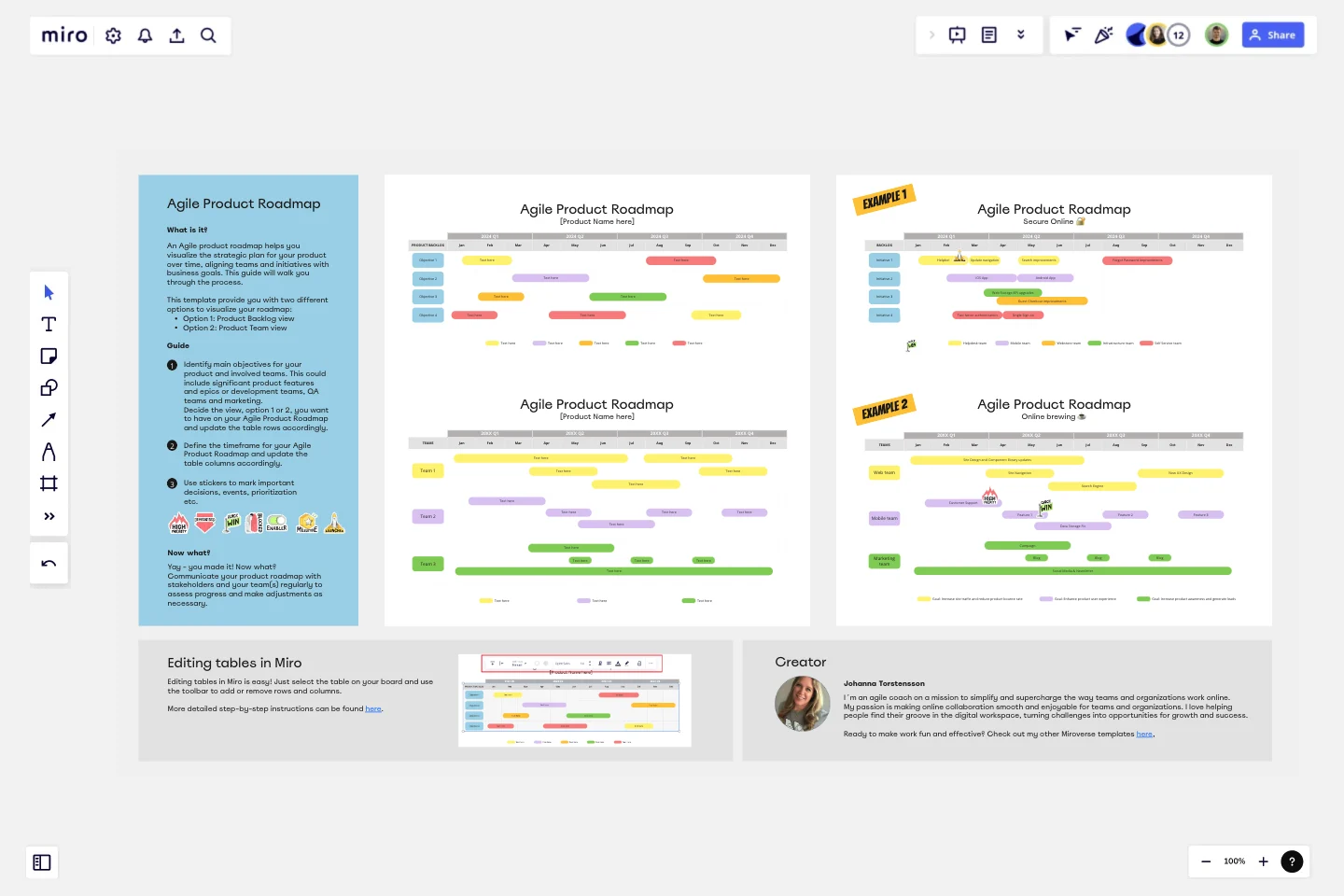Agile Product Roadmap by Johanna Torstensson
An Agile product roadmap helps you visualize the strategic plan for your product over time, aligning teams and initiatives with business goals.
This template provide a guide to create your own Agile Product Roadmap with two different options to visualize your roadmap:
Option 1: Product Backlog view
Option 2: Product Team view
Who is it for?
An agile product roadmap is a strategic tool used by various roles within an organization to guide product development and deliveries:
Product Owner: Uses the roadmap to prioritize features, communicate vision, and align the team's work with business goals.
Scrum Master: Utilizes it to facilitate sprint planning, manage workloads, and ensure the team remains focused on delivering value.
Development Team: Refers to the roadmap to understand upcoming work and how their tasks contribute to overall goals.
Stakeholders (Executives, Marketing, Sales): Stay informed about product direction and upcoming releases to align their strategies.
UX/UI Designers: Plan user research and design sprints to align with upcoming features.
Project Managers: Track progress, manage risks, and ensure development stays on schedule.
How to use it?
There is a simple step-by-step guide in the template how to create you own Agile Product Roadmap. This will be a perfect tool to communicate your product´s vision for the upcoming period and to keep track on the deliveries.
This template was created by Johanna Torstensson.
Get started with this template right now.
Agile Roadmap Template
Works best for:
Agile Methodology, Roadmaps, Agile Workflows
A roadmap is just as important as sprints and standups for getting Agile right. Use this template to create, revise, and communicate an Agile roadmap in collaboration with your project team.
Technology Roadmap Template
Works best for:
Agile Methodology, Roadmaps, Agile Workflows
A technology roadmap helps teams document the rationale of when, why, how, and what tech-related solutions can help the company move forward. Also known as IT roadmaps, technology roadmaps show teams what technology is available to them, focusing on to-be-scheduled improvements. They allow you to identify gaps or overlap between phased-out tech tools, as well as software or programs soon to be installed. From a practical point of view, the roadmap should also outline what kinds of tools are best to spend money on, and the most effective way to introduce new systems and processes.
SMART Agile Product Roadmap
Works best for:
Product Roadmap
Plan and manage your product development with the Smart Agile Product Roadmap. This template supports agile methodologies, helping you outline product features, set timelines, and prioritize tasks. Visualize the development process, track progress, and adjust plans as needed. Ideal for product managers, development teams, and agile practitioners, it ensures your product roadmap is clear, flexible, and aligned with business goals, enhancing collaboration and productivity.
Epic & Feature Roadmap Planning
Epic & Feature Roadmap Planning template facilitates the breakdown of large-scale initiatives into manageable features and tasks. It helps teams prioritize development efforts based on business impact and strategic objectives. By visualizing the relationship between epics and features, teams can effectively plan releases and ensure alignment with overall project goals and timelines.
Thematic Roadmapping (Vision & Strategy)
Works best for:
Roadmap, Planning, Mapping
The Thematic Roadmapping (Vision & Strategy) template empowers organizations to align their vision with actionable strategies. By identifying key themes and strategic objectives, teams can develop a roadmap that guides decision-making and resource allocation. This template facilitates cross-functional collaboration and ensures that initiatives are aligned with overarching goals, leading to more focused and impactful execution.
Recruitment Strategy Roadmap
Works best for:
Roadmap, Planning, Mapping
The Recruitment Strategy Roadmap template helps organizations plan and execute their talent acquisition initiatives effectively. It provides a structured framework for identifying hiring needs, sourcing candidates, and evaluating recruitment channels. By aligning recruitment efforts with business objectives, organizations can attract and retain top talent, driving organizational growth and success.
